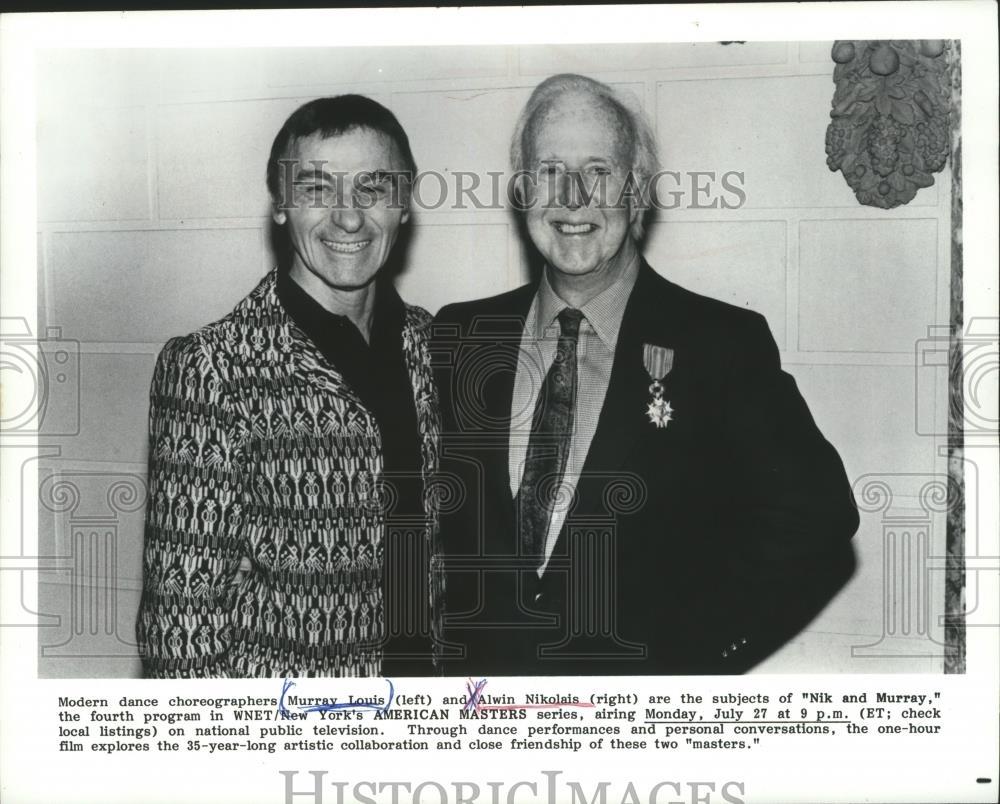 Alwin Nikolais (November 25, 1910 in Southington, Connecticut – May 8,
1993) was an American choreographer.
Alwin Nikolais (November 25, 1910 in Southington, Connecticut – May 8,
1993) was an American choreographer. Partner Murray Louis
Queer Places:
Cimetière du Père Lachaise Paris, City of Paris, Île-de-France, France
 Alwin Nikolais (November 25, 1910 in Southington, Connecticut – May 8,
1993) was an American choreographer.
Alwin Nikolais (November 25, 1910 in Southington, Connecticut – May 8,
1993) was an American choreographer.
Nikolais studied piano at an early age and began his performing career as an organist accompanying silent films. As a young artist, he gained skills in scenic design, acting, puppetry and music composition. It was after attending a performance by the German dancer Mary Wigman that he was inspired to study dance. He received his early dance training at Bennington College from the great figures of the modern dance world: Hanya Holm, Martha Graham, Doris Humphrey, Charles Weidman, Louis Horst, and others.
In 1940, in collaboration with Truda Kaschmann, his first modern dance teacher, Nikolais received a commission to create Eight Column Line, his first ballet. The work was presented at one of the events of Hartford social season that counted Salvador Dalí and Léonide Massine as honorary patrons and was well received.
After teaching two years at his own studio and touring the US with dancers from Hanya Holm's company, Nikolais did active duty in the Army during World War II as a master sergeant in criminal investigation. Nikolais relocated to New York City following the war and resumed studying with Hanya Holm. Eventually, he became Holm's assistant, teaching at her New York school and at Colorado College during the summers. In 1948, Nikolais was appointed director of the Henry Street Playhouse, which had been left in a state of transition and had to be entirely re-established. He formed the Playhouse Dance Company, which was later renamed and known as the Nikolais Dance Theatre. It was at Henry Street that Nikolais began to develop his own world of abstract dance theatre, portraying man as part of a total environment. Nikolais redefined dance, as "the art of motion which, left on its own merits, becomes the message as well as the medium". He Stated "The Province of art is to explore the inner mechanisms and extra dimensional areas of life and, out of the exploration, to produce its findings translated into the form of the artist's media." It was also at Henry Street Playhouse that Mr. Nikolais was joined by Murray Louis, who was to become a driving force in the Playhouse Company, Nikolais' leading dancer and longtime collaborator.
In 1956, the Nikolais Dance Theater was invited to its first of many appearances at the American Dance Festival. With this, and a number of appearances on televisions The Steve Allen Show, his total dance theatre had begun to take shape, and the company established itself in the forefront of American contemporary dance. In the 1960s his choreographic artistry was showcased once again on live network television for the CBS Repertoire Workshop.[1] With the company's 1968 Paris season at the Théâtre des Champs-Élysées, Nikolais' impact on dance grew internationally. Following Paris, the company began performing around the world. Here began a long artistic relationship with the Théâtre de la Ville which began in 1971 and continues now after his death.
In 1978, the French National Ministry of Culture invited him to form the Centre Nationale de la Danse Contemporaine in Angers, France. In December 1980, he created his 99th choreographic work Schema, for the Paris Opera. At the same time, his choreography for an opera by Gian Carlo Menotti was being staged at the Vienna Staatsoper.
In 1987, Nikolais was awarded the National Medal of Arts, bestowed by President Ronald Reagan, and the Kennedy Center Honors, conferred during a three-day round of official Washington events, which culminated in a CBS telecast featuring the Nikolais Dance Theater. Alwin Nikolais gave the world a new vision of dance and was named the "father of multi-media theater." [2] He received the City of Paris' highest honor, the Grande Medaille de Vermeille de la Ville de Paris, as well as medals from Seville, Spain, Athens, Greece, and 30 other cities both foreign and national as well as a special citation from New York City's Mayor, which he shared with Murray Louis. Often referred to as the American Patriarch of French modern dance, Nikolais is a knight of France's Legion of Honor and a commander of the Order of Arts and Letters.
His accolades from the world of arts and letters included the Samuel H. Scripps American Dance Festival Award; the Capezio Award; Circulo Criticos Award, Chile; Emmy Citation Award; Dance Magazine Award; the Tiffany Award; and the American Dance Guild Award. In 2000 he was inducted into the National Museum of Dance's Mr. & Mrs. Cornelius Vanderbilt Whitney Hall of Fame.
Nikolais was granted five honorary doctorate degrees, was twice designated a Guggenheim Fellow, and was the recipient of a three-year creativity grant from the Andrew W. Mellon Foundation. Mr. Nikolais and his work have been featured in numerous films and television programs in the US and abroad. In July 1987, Nik and Murray, a feature-length documentary film about Nikolais and Murray Louis, directed by Christian Blackwood, aired on the PBS series American Masters.
Nikolais was renowned as a master teacher, and his pedagogy is taught in schools and universities throughout the world. He died of cancer May 8, 1993, in New York and is buried in Père Lachaise Cemetery in Paris.
Nikolais purchased the first Moog analog synthesizer system.
My published books: